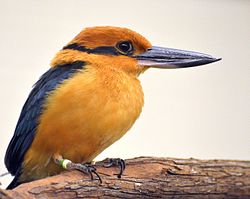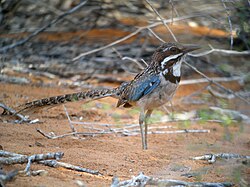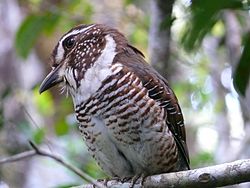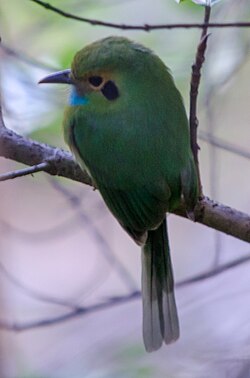| Common name | Binomial name | Population | Status | Trend | Notes | Image |
|---|
| Guam kingfisher | Todiramphus cinnamominus | 0 [3] | EW [3] | NA [3] | Last wild individual was observed in 1988. [3] There are approximately 135 individuals currently held in captivity. [4] |  |
| Sangihe dwarf kingfisher | Ceyx sangirensis | 1-249 [5] | CR [5] |  [5] [5] | |  |
| Javan blue-banded kingfisher | Alcedo euryzona | 50-249 [6] | CR [6] |  [6] [6] | Note that IOC taxonomy splits an additional species, the Malaysian blue-banded kingfisher, from this species. [2] IUCN/BirdLife International maintain both species within A. euryzona. [7] |  |
| Tuamotu kingfisher (Mangareva kingfisher) | Todiramphus gambieri | 100-150 [8] | CR [8] |  [8] [8] | Surveys in 2019 estimated 173 individuals in total. [8] Note that IOC taxonomy splits an additional species, the Niau kingfisher, from this species. [2] IUCN/BirdLife International maintain both species within T. gambieri. [7] |  |
| Marquesas kingfisher (Marquesan kingfisher) | Todiramphus godeffroyi | 350 [9] | CR [9] |  [9] [9] | Numbered 695 in 2003. Numbered approximately 350 mature individuals in 2014. [9] |  |
| Kofiau paradise kingfisher | Tanysiptera ellioti | 350 - 1,500 [10] | NT [10] |  [10] [10] | Population is considered "very unlikely to number fewer than 1,000 mature individuals." [10] |  |
| Sula dwarf kingfisher | Ceyx wallacii | 580-5,800 [11] | NT [11] |  [11] [11] | Best estimate for number of mature individuals is 2,500-5,000. [11] |  |
| Southern indigo-banded kingfisher | Ceyx nigrirostris | 1,000-2,499 [12] | NT [12] |  [12] [12] | Note that IOC taxonomy maintains this species as a single species with the Northern indigo-banded kingfisher under C. cyanopectus, as indigo-banded kingfisher. [2] |  |
| Manus dwarf kingfisher | Ceyx dispar | 1,100-5,600 [13] | NT [13] |  [13] [13] | Best estimate for number of mature individuals is 2,500-5,000. Total population is estimated to be 1,700-8,500 individuals. [13] | |
| Northern silvery kingfisher | Ceyx flumenicola | 1,200-6,000 [14] | NT [14] |  [14] [14] | Best estimate for number of mature individuals is 2,500-5,000. Total population is estimated to be 1,800-9,000 individuals. [14] |  |
| Moustached kingfisher | Actenoides bougainvillei | 1,300-7,000 [15] | LC [15] |  [15] [15] | Best estimate for number of mature individuals is 2,500-5,000. [15] |  |
| Southern silvery kingfisher | Ceyx argentatus | 1,300-13,000 [16] | NT [16] |  [16] [16] | Best estimate for number of mature individuals is 2,500-9,999. Total population is estimated to be 2,000-20,000 individuals. [16] |  |
| Keel-billed motmot | Electron carinatum | 1,500-7,000 [17] | VU [17] |  [17] [17] | |  |
| Scaly ground-roller | Geobiastes squamiger | 1,500-7,000 [18] | VU [18] |  [18] [18] | |  |
| Azure dollarbird | Eurystomus azureus | 1,500-7,000 [19] | NT [19] |  [19] [19] | Possibly up to 2,500-9,999 individuals based on an assessment of known records, descriptions of abundance and range size. [19] |  |
| Palau kingfisher (Rusty-capped kingfisher) | Todiramphus pelewensis | 2,100-3,300 [20] | NT [20] | ? [20] | Best estimate for number of mature individuals is 2,700. Total population is estimated to be ~ 4,100 individuals. [20] |  |
| Mangaia kingfisher (Mewing kingfisher) | Todiramphus ruficollaris | 2,100-3,500 [21] | LC [21] |  [21] [21] | Best estimate for number of mature individuals is 2,700. May have been underestimated in previous surveys. [21] |  |
| Bismarck kingfisher | Ceyx websteri | 2,500-9,999 [22] | VU [22] |  [22] [22] | |  |
| Rufous-lored kingfisher (Winchell's kingfisher) | Todiramphus winchelli | 2,500-9,999 [23] | VU [24] |  [24] [24] | Values given are a preliminary estimate from this species' 2016 assessment. [23] Current 2025 assessment lists the population as "unknown." [24] |  |
| New Britain kingfisher (White-mantled kingfisher) | Todiramphus albonotatus | 2,500-9,999 [25] | NT [25] |  [25] [25] | |  |
| Numfor paradise-kingfisher | Tanysiptera carolinae | 2,500-9,999 [26] | NT [26] |  [26] [26] | |  |
| Blue-black kingfisher | Todiramphus nigrocyaneus | 2,500-9,999 [27] | NT [27] |  [27] [27] | |  |
| Chattering kingfisher | Todiramphus tutus | 2,500-9,999 [28] | NT [28] |  [28] [28] | |  |
| Blyth's kingfisher | Alcedo hercules | 2,500-9,999 [29] | NT [29] |  [29] [29] | |  |
| Talaud kingfisher | Todiramphus enigma | 3,000-15,000 [30] | NT [30] |  [30] [30] | |  |
| Buru dwarf kingfisher | Ceyx cajeli | 4,000-20,000 [31] | NT [31] |  [31] [31] | Best estimate for number of mature individuals is 4,000-9,999. Total population is estimated to be 6,000-30,000 individuals. [31] |  |
| Cinnamon-banded kingfisher | Todiramphus australasia | 9,250-18,500 [32] | LC [32] |  [32] [32] | Best estimate for number of mature individuals is 12,000-18,000. Total population is estimated to be 14,000-28,000 individuals. [32] |  |
| Long-tailed ground-roller | Uratelornis chimaera | 9,487-32,687 [33] | VU [33] |  [33] [33] | Values given are a 95% confidence interval around the estimate of 21,124 mature individuals. [33] |  |
| Pohnpei kingfisher | Todiramphus reichenbachii | 10,000-19,999 [34] | VU [34] |  [34] [34] | |  |
| Short-legged ground-roller | Brachypteracias leptosomus | 10,000-25,000 [35] | VU [35] |  [35] [35] | |  |
| Sombre kingfisher | Todiramphus funebris | 10,000-25,000 [36] | LC [36] |  [36] [36] | Best estimate for number of mature individuals is 15,000-25,000. Total population is estimated to be 15,000-35,000 individuals. [36] |  |
| San Cristobal dwarf kingfisher (Makira dwarf kingfisher) | Ceyx gentianus | 10,000-30,000 [37] | LC [37] |  [37] [37] | |  |
| Blue-capped kingfisher (Hombron's kingfisher) | Actenoides hombroni | 10,000 - 99,999 [38] | LC [38] |  [38] [38] | "The population size of this species is unknown. The population probably still numbers tens of thousands of individuals." [38] |  |
| Lazuli kingfisher | Todiramphus lazuli | 12,000 - 18,000 [39] | LC [39] |  [39] [39] | Best estimate for number of mature individuals is 15,000. [39] |  |
| Vanuatu kingfisher | Todiramphus farquhari | 14,000-94,000 [40] | NT [40] |  [40] [40] | |  |
| Blue-throated motmot | Aspatha gularis | 20,000-49,999 [41] | LC [41] |  [41] [41] | |  |
| Tody motmot | Hylomanes momotula | 20,000-49,999 [42] | LC [42] |  [42] [42] | |  |
| Blue-capped motmot (Blue-crowned motmot) | Momotus coeruliceps | 20,000-49,999 [43] | LC [43] |  [43] [43] | |  |
| Sangihe lilac kingfisher | Cittura sanghirensis | 21,000-78,000 [44] | LC [44] |  [44] [44] | Total population is estimated to be 42,200–97,400 individuals. [44] |  |
| Brown-winged kingfisher | Pelargopsis amauroptera | 25,000-35,000 [45] | NT [45] |  [45] [45] | |  |
| Russet-crowned motmot | Momotus mexicanus | 50,000-499,999 [46] | LC [46] |  [46] [46] | |  |
| Whooping motmot | Momotus subrufescens | 50,000-499,999 [47] | LC [47] |  [47] [47] | |  |
| Tahiti kingfisher (Society kingfisher) | Todiramphus veneratus | 100,000-199,999 [48] | NT [48] |  [48] [48] | |  |
| European roller | Coracias garrulus | 100,000-499,999 [49] | LC [49] |  [49] [49] | |  |
| Blue-cheeked bee-eater | Merops persicus | 150,000-400,000 [50] | LC [50] |  [50] [50] | |  |
| Broad-billed motmot | Electron platyrhynchum | 500,000-4,999,999 [51] | LC [51] |  [51] [51] | |  |
| Turquoise-browed motmot | Eumomota superciliosa | 500,000-4,999,999 [52] | LC [52] |  [52] [52] | |  |
| Blue-diademed motmot (Lesson's motmot) | Momotus lessonii | 500,000-4,999,999 [53] | LC [53] |  [53] [53] | |  |
| Amazon kingfisher | Chloroceryle amazona | 500,000-4,999,999 [54] | LC [54] |  [54] [54] | |  |
| American pygmy-kingfisher | Chloroceryle aenea | 500,000-4,999,999 [55] | LC [55] |  [55] [55] | |  |
| Green-and-rufous kingfisher | Chloroceryle inda | 500,000-4,999,999 [56] | LC [56] |  [56] [56] | |  |
| Rainbow bee-eater | Merops ornatus | 670,000 [57] | LC [57] |  [57] [57] | Estimated to number at least 1 million individuals in 2008. [57] |  |
| Common kingfisher | Alcedo atthis | 716,000-1,760,000 [58] | LC [58] |  [58] [58] | |  |
| Belted kingfisher | Megaceryle alcyon | 1,800,000 [59] | LC [59] |  [59] [59] | |  |
| Rufous motmot | Baryphthengus martii | 5,000,000-49,999,999 [60] | LC [60] |  [60] [60] | |  |
| European bee-eater | Merops apiaster | 18,400,000-28,000,000 [61] | LC [61] |  [61] [61] | |  |
| Green kingfisher | Chloroceryle americana | 20,000,000 [62] | LC [62] |  [62] [62] | |  |
| Ringed kingfisher | Megaceryle torquata | 20,000,000 [63] | LC [63] |  [63] [63] | |  |
|




























































